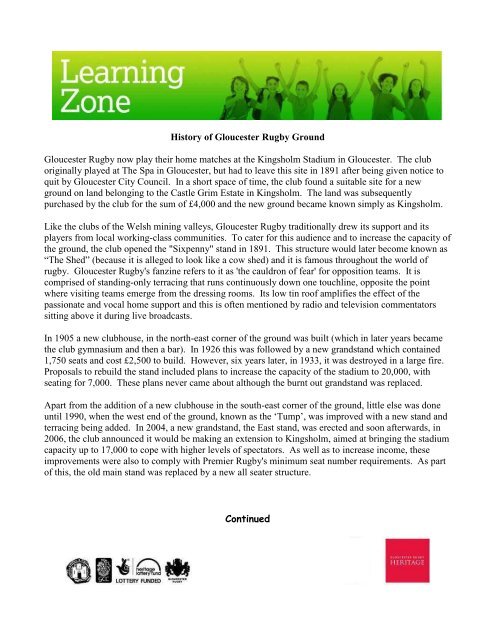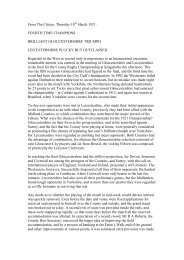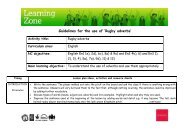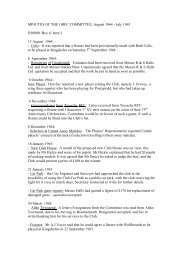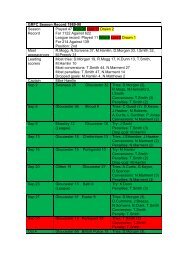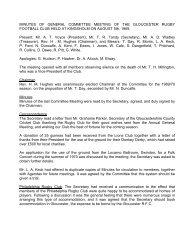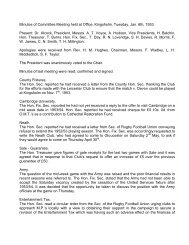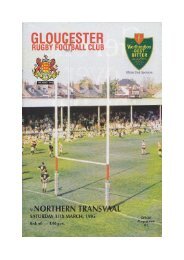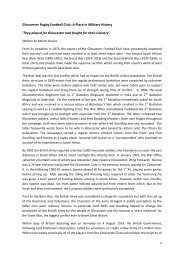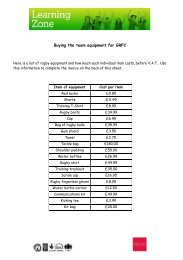History of Gloucester Rugby Ground - Gloucester Rugby Heritage
History of Gloucester Rugby Ground - Gloucester Rugby Heritage
History of Gloucester Rugby Ground - Gloucester Rugby Heritage
Create successful ePaper yourself
Turn your PDF publications into a flip-book with our unique Google optimized e-Paper software.
<strong>History</strong> <strong>of</strong> <strong>Gloucester</strong> <strong>Rugby</strong> <strong>Ground</strong><br />
<strong>Gloucester</strong> <strong>Rugby</strong> now play their home matches at the Kingsholm Stadium in <strong>Gloucester</strong>. The club<br />
originally played at The Spa in <strong>Gloucester</strong>, but had to leave this site in 1891 after being given notice to<br />
quit by <strong>Gloucester</strong> City Council. In a short space <strong>of</strong> time, the club found a suitable site for a new<br />
ground on land belonging to the Castle Grim Estate in Kingsholm. The land was subsequently<br />
purchased by the club for the sum <strong>of</strong> £4,000 and the new ground became known simply as Kingsholm.<br />
Like the clubs <strong>of</strong> the Welsh mining valleys, <strong>Gloucester</strong> <strong>Rugby</strong> traditionally drew its support and its<br />
players from local working-class communities. To cater for this audience and to increase the capacity <strong>of</strong><br />
the ground, the club opened the "Sixpenny" stand in 1891. This structure would later become known as<br />
“The Shed” (because it is alleged to look like a cow shed) and it is famous throughout the world <strong>of</strong><br />
rugby. <strong>Gloucester</strong> <strong>Rugby</strong>'s fanzine refers to it as 'the cauldron <strong>of</strong> fear' for opposition teams. It is<br />
comprised <strong>of</strong> standing-only terracing that runs continuously down one touchline, opposite the point<br />
where visiting teams emerge from the dressing rooms. Its low tin ro<strong>of</strong> amplifies the effect <strong>of</strong> the<br />
passionate and vocal home support and this is <strong>of</strong>ten mentioned by radio and television commentators<br />
sitting above it during live broadcasts.<br />
In 1905 a new clubhouse, in the north-east corner <strong>of</strong> the ground was built (which in later years became<br />
the club gymnasium and then a bar). In 1926 this was followed by a new grandstand which contained<br />
1,750 seats and cost £2,500 to build. However, six years later, in 1933, it was destroyed in a large fire.<br />
Proposals to rebuild the stand included plans to increase the capacity <strong>of</strong> the stadium to 20,000, with<br />
seating for 7,000. These plans never came about although the burnt out grandstand was replaced.<br />
Apart from the addition <strong>of</strong> a new clubhouse in the south-east corner <strong>of</strong> the ground, little else was done<br />
until 1990, when the west end <strong>of</strong> the ground, known as the „Tump‟, was improved with a new stand and<br />
terracing being added. In 2004, a new grandstand, the East stand, was erected and soon afterwards, in<br />
2006, the club announced it would be making an extension to Kingsholm, aimed at bringing the stadium<br />
capacity up to 17,000 to cope with higher levels <strong>of</strong> spectators. As well as to increase income, these<br />
improvements were also to comply with Premier <strong>Rugby</strong>'s minimum seat number requirements. As part<br />
<strong>of</strong> this, the old main stand was replaced by a new all seater structure.<br />
Continued
<strong>History</strong> <strong>of</strong> <strong>Gloucester</strong> <strong>Rugby</strong> <strong>Ground</strong><br />
In January 2007, the Club announced that it planned to redevelop The Shed. This was to enable the<br />
stadium to become all-seating. A large number <strong>of</strong> supporters did not want to see this happen, and a<br />
campaign under the banner <strong>of</strong> "Save Our Shed" or "SOS" was begun. Posters were held up during a<br />
protest before one game and T-shirts were made with the slogan “Save Our Shed” on them.<br />
A suggested compromise was for the Club to replicate the design <strong>of</strong> Northampton RFC‟s ground,<br />
Franklin's Gardens, where terracing runs in conjunction with a large seated area. In September 2008,<br />
Chairman Tom Wilkinshaw confirmed that the plans for the Shed would see it remain as a terrace (with<br />
an increased capacity <strong>of</strong> 6000), with hospitality units above it.<br />
2007 also saw the Club reject the proposal <strong>of</strong> a new 20,000 all seater stadium in an area <strong>of</strong> the city<br />
nicknamed "The Railway Triangle". This proposal also called for the new ground to be shared with the<br />
local football side, <strong>Gloucester</strong> City A.F.C. In October <strong>of</strong> the same year, Kingsholm was also suggested<br />
as a possible temporary home for the football side after their Meadow Park stadium was flooded and<br />
then abandoned following the extreme summer flooding. However, this move was rejected by the then<br />
owner Tom Walkinshaw.


